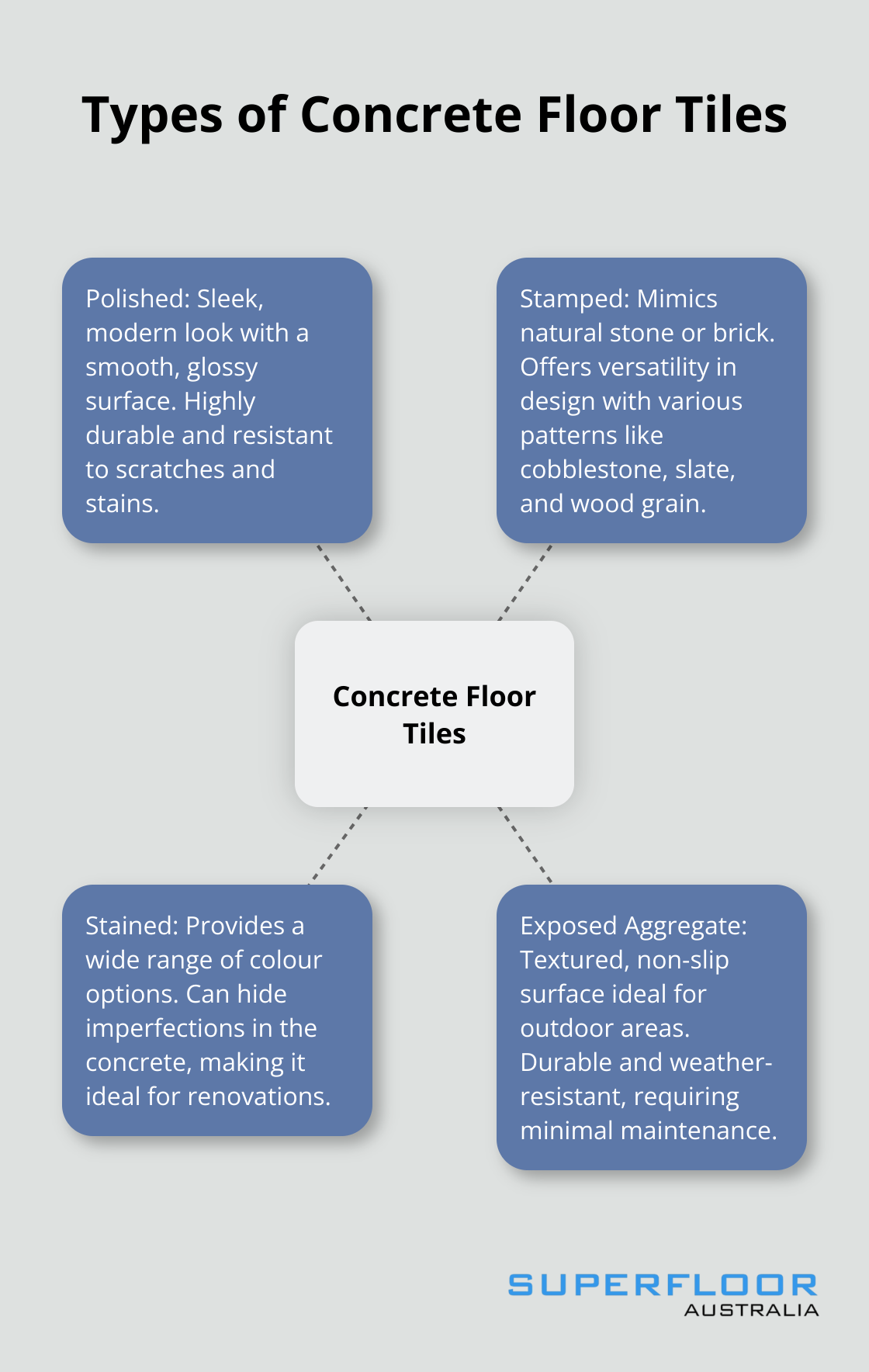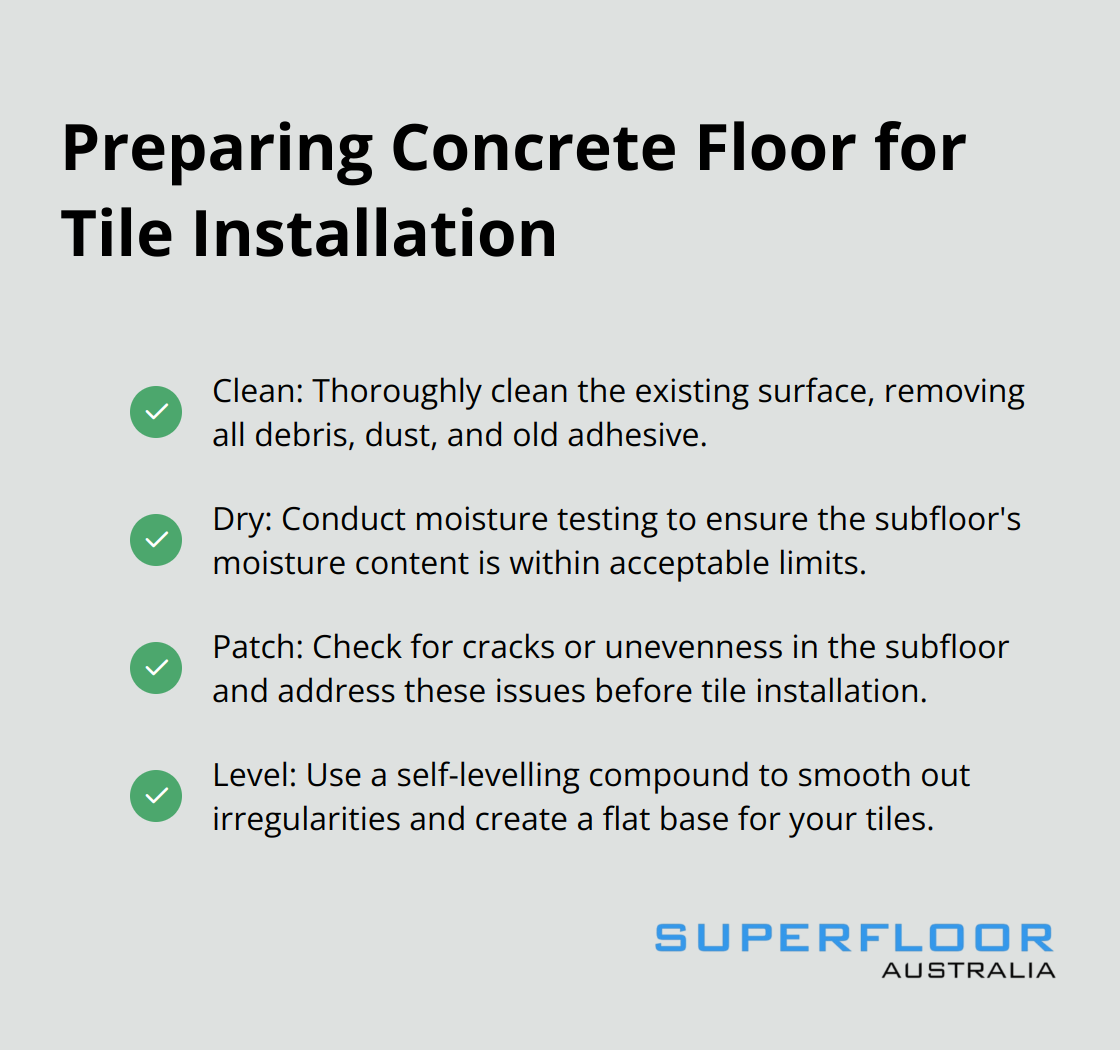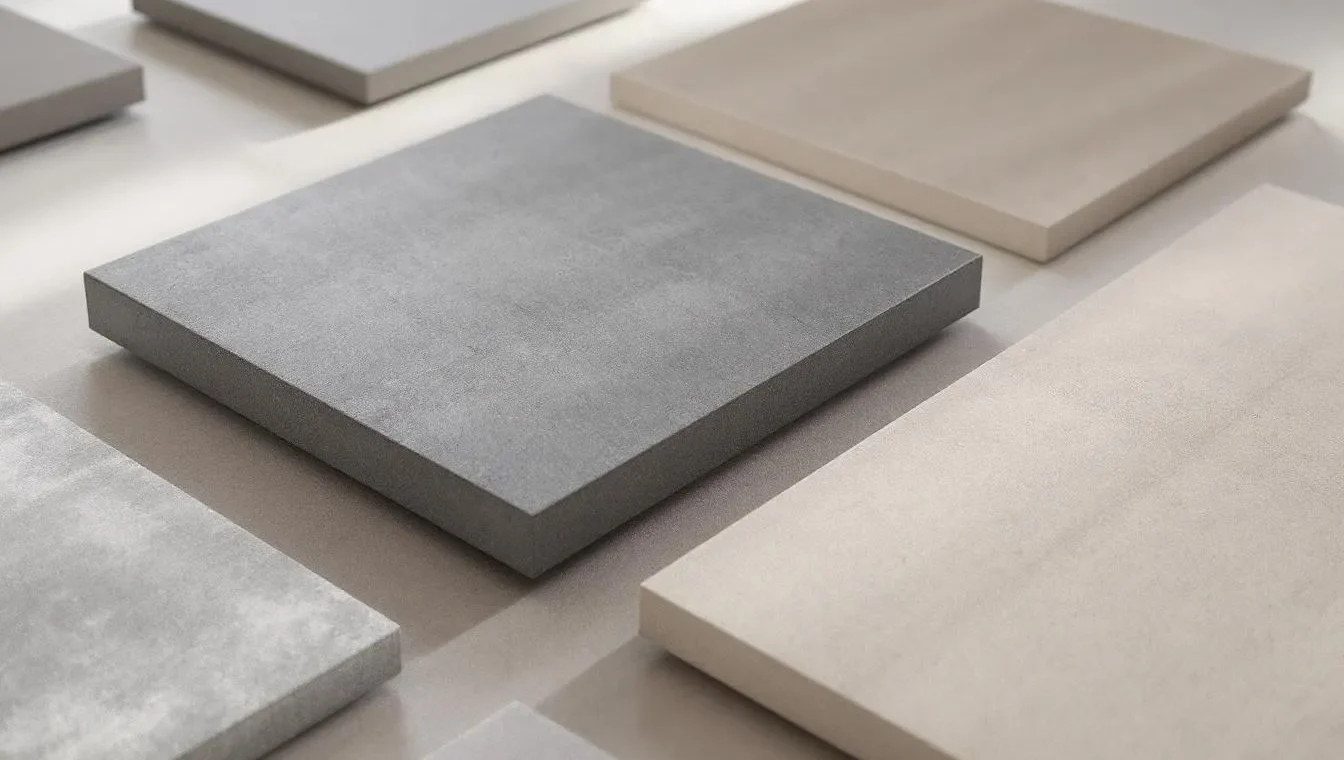Concrete floor tiles have become a popular choice for both residential and commercial spaces. At Superfloor Australia, we’ve seen a surge in demand for these versatile and durable flooring options.
This guide will help you navigate the world of floor tiles concrete, exploring different types, key factors to consider, and essential maintenance tips. Whether you’re renovating your home or designing a new commercial space, we’ll provide you with the knowledge to make an informed decision.
Types of Concrete Floor Tiles
Concrete floor tiles offer a diverse range of options for both residential and commercial spaces. Let’s explore the main types you’ll encounter in the market.
Polished Concrete Tiles
Polished concrete tiles provide a sleek, modern look. These tiles undergo a multi-step grinding process that results in a smooth, glossy surface. You can customise the level of shine to your preference (ranging from a matte finish to a high-gloss sheen).
The durability of polished concrete tiles stands out as a key advantage. They resist scratches, stains, and heavy foot traffic, which makes them ideal for various settings. Polished concrete floors require minimal upkeep, with regular cleaning and occasional re-polishing usually sufficient to maintain their appearance.
Stamped Concrete Tiles
Stamped concrete tiles offer the look of natural stone or brick without the high cost. Manufacturers create these tiles by pressing moulds into wet concrete, which produces patterns and textures that mimic more expensive materials.
The versatility in design sets stamped concrete tiles apart. You can select from a wide range of patterns (including cobblestone, slate, and wood grain). Stamped concrete flooring generally adds to a home’s value on resale.
Stained Concrete Tiles
Stained concrete tiles allow for a wide range of colour options, from subtle earth tones to bold, vibrant hues. The staining process involves the application of acid-based or water-based stains to the concrete surface. These stains react chemically with the concrete to create unique colour effects.
One benefit of stained concrete tiles is their ability to hide imperfections in the concrete. This quality makes them a popular choice for renovating older concrete floors.

Exposed Aggregate Concrete Tiles
Exposed aggregate concrete tiles offer a textured, non-slip surface that works well for outdoor areas. Manufacturers create these tiles by removing the top layer of cement paste to reveal the aggregate (stones, pebbles, or river rocks) beneath.
The durability and weather resistance of these tiles make them ideal for pool decks, patios, and driveways. They also require minimal maintenance – a simple pressure wash once or twice a year usually suffices to keep them looking great.
When you select concrete floor tiles, consider factors like the intended use of the space, your aesthetic preferences, and your budget. The next section will explore these factors in more detail to help you make an informed decision.
Factors to Consider When Choosing Concrete Floor Tiles
Durability and Strength
Polished concrete excels in high-traffic areas. It resists the constant movement of people, heavy equipment, and machinery without showing signs of wear. The quality of the subfloor also plays a vital role in the overall durability of your flooring system.
Aesthetic Appeal and Design Options
Modern concrete floor tiles offer an impressive range of design choices. Cement-look tiles are available in various shades, patterns, and finishes, complementing any design theme from minimalist to industrial chic.
Colour choices have expanded significantly. Vibrant reds for restaurant floors and subtle earth tones for residential spaces are now possible. Some manufacturers even offer custom colour matching to align perfectly with specific brand or interior design requirements.

Maintenance Requirements
While concrete floor tiles generally require low maintenance, different finishes need varying levels of care. Polished concrete tiles may need periodic resealing to maintain their glossy appearance. Honed concrete tiles, on the other hand, often require less frequent upkeep.
Most concrete floor tiles only need regular sweeping and occasional mopping with a pH-neutral cleaner. This makes them an excellent choice for busy households or commercial spaces where extensive maintenance isn’t practical.
Cost-Effectiveness
Initial costs for concrete floor tiles can vary widely. However, it’s important to consider the long-term value. High-quality concrete tiles can last for decades with proper care, often outlasting cheaper alternatives.
Investing in premium concrete tiles has resulted in significant savings over time, particularly in commercial settings where frequent replacements can be costly and disruptive.
Environmental Impact
Sustainability is increasingly important in flooring choices. Concrete floor tiles score well in this aspect. Many manufacturers now use recycled materials in their production process, reducing environmental impact.
Moreover, the longevity of concrete tiles means less frequent replacements, further reducing waste. Some clients have even opted for locally produced tiles to minimise transportation-related emissions.
The selection of concrete floor tiles requires careful consideration of these factors. Your specific needs, budget, and design preferences will guide your decision. The next section will explore the installation and maintenance processes, which are crucial for maximising the lifespan and appearance of your chosen concrete floor tiles.
How to Install and Maintain Concrete Floor Tiles
Subfloor Preparation: The Foundation of Success
Proper subfloor preparation is essential for a long-lasting concrete tile floor. There are four simple principles to help you prepare concrete floor for tile installation: clean, dry, patch, and level. Start by thoroughly cleaning the existing surface. Remove all debris, dust, or old adhesive. Check for cracks or unevenness in the subfloor and address these issues before tile installation.

For uneven surfaces, use a self-levelling compound to smooth out irregularities. This creates a flat base for your tiles. Allow the compound to dry completely before proceeding (this typically takes 24 to 48 hours, depending on the product and environmental conditions).
Moisture testing is another important step. Excess moisture can lead to tile lifting or efflorescence. Use a moisture meter to ensure the subfloor’s moisture content is within acceptable limits. If it’s too high, apply a moisture barrier before installation.
Professional Installation: Precision and Expertise
Professional installation often yields superior results. Experienced installers have the tools and knowledge to handle unexpected challenges and ensure a flawless finish.
The installation process typically begins with laying out the tiles dry to determine the best pattern and to identify any necessary cuts. This step helps minimise waste and ensures a balanced look, especially in rooms with irregular shapes.
Next, apply the adhesive using a notched trowel. Use the right type of adhesive for concrete tiles (typically, a polymer-modified thinset mortar is recommended). Place tiles carefully, using spacers to maintain consistent gaps.
After the adhesive has set (usually 24 to 48 hours), begin grouting. Choose a grout colour that complements your tiles. Apply the grout using a rubber float, making sure to fill all joints completely. After the grout has set slightly, clean the excess from the tile surface with a damp sponge.
Maintenance: Preserving Beauty and Functionality
Regular maintenance keeps your concrete floor tiles looking their best. For daily cleaning, sweep or vacuum to remove loose dirt and debris. For deeper cleaning, use a pH-neutral cleaner specifically designed for concrete tiles. Avoid acidic or abrasive cleaners, as these can damage the tile surface.
Sealing is an important part of maintenance for many types of concrete tiles. A sealer should only be applied after freshly laid concrete has been allowed to cure for 28 days. You can also seal old or existing concrete. The frequency of sealing depends on the specific type of tile and the amount of traffic it receives.
Addressing Common Issues: Quick Action for Lasting Results
Even with proper installation and maintenance, issues can sometimes arise. Address cracks in tiles or grout lines promptly to prevent further damage. Fill small cracks with a colour-matched epoxy filler.
Remove efflorescence (if it occurs) with a specialised cleaner. However, if the problem persists, it may indicate an underlying moisture issue that needs professional attention.
Clean stains as quickly as possible. For stubborn stains, a poultice made from baking soda and water can be effective. Apply the paste to the stain, cover with plastic wrap, and leave for 24 hours before rinsing.
These installation and maintenance guidelines will help ensure your concrete floor tiles remain beautiful and functional for years to come. While some maintenance tasks can be handled by property owners, consult professionals for more complex issues or large-scale maintenance needs.
Final Thoughts
Concrete floor tiles offer a perfect blend of durability, aesthetics, and versatility for various spaces. The selection process involves weighing factors such as strength, design options, maintenance needs, cost-effectiveness, and environmental impact. Different types of tiles (polished, stamped, stained, and exposed aggregate) cater to diverse preferences and requirements.
Professional installation and proper maintenance will maximise the lifespan and appearance of your concrete floor tiles. Regular cleaning, timely sealing, and prompt addressing of issues ensure long-lasting beauty and functionality. The initial investment in high-quality tiles often results in significant long-term savings due to their durability and low maintenance requirements.
We at Superfloor Australia specialise in polished concrete flooring and concrete honing for homes, commercial spaces, and industrial settings in Brisbane. Our expertise can help you select the ideal floor tiles concrete for your project (whether residential or commercial). Contact us to transform your space with stunning and functional concrete flooring solutions.
